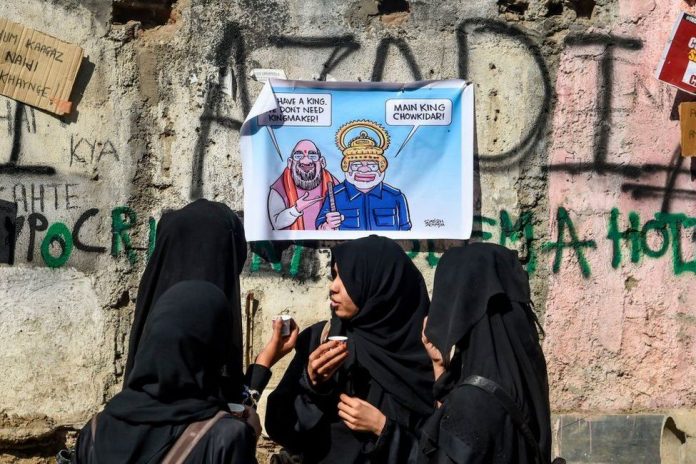Muslim women received significantly more abuse when compared to women from other religions. They received 55.5% more problematic or abusive content.
Suchitra | TwoCircles.net
NEW DELHI — In February last year, 17-year-old Asra Hamid Rashid woke up to hundreds of messages on her Instagram abusing her, sending her rape and death threats.
“They broke me, not just on social media, but in my personal life. I do not know how somebody can have so much hate to sustain a hate-filled campaign against a 17-year-old young girl for two straight weeks,” Asra told TwoCircles.net.
Asra, a Muslim queer woman, is a law student in West Bengal and has been vocal against the ruling party, and the growing Hindu extremism. Her experiences are not different from other Muslim women online. Muslim women have been experiencing extreme social media harassment ranging from abuses, slurs to active death and rape threats.
Amnesty India’s findings in 2020 saw that 1 in 5 of their analyzed tweets was misogynistic abuse. Muslim Women received significantly more abuse when compared to women from other religions. They received 55.5% more problematic or abusive content. 26.4% of the problematic or abusive content experienced by them contained ethnic/religious slurs. Women from marginalized castes receive 59% more caste-based abuse than women from general castes.
Mariya Salim is a researcher and gender rights activist. worked with Amnesty, Inter Press Service among others. “Online violence can often translate into real-life violence, and that threat, that fear is difficult to navigate. Especially for Muslim, Dalit and queer women, the violence then becomes all the more intersectional.”
The kind of words that are used specifically for women from Muslim communities is intended to silence them, with an added layer of humiliation with religious, ethnic slurs.
“If they see you are outspoken, in cases of online harassment by the right-wing, as soon as they see that it’s a woman the nature of the abuse changes,” Asra said.
Mariya interviewed women who are public figures and often face vicious online harassment while she worked for Amnesty India.
“Imagine writing about this online harassment so many times and then waking up to being auctioned by the right-wing, and on New Year’s Eve of all days,” Mariya said, referring to the Github Bulli Bai app. “Online violence is scary for women because of the very real danger it brings, and the intention is always to silence, as I have found from my work and my personal experiences.”
Online abuse has the power to belittle, demean, intimidate and eventually silence women, she said.
Around two-thirds of women who experienced abuse or harassment on social media platforms said to Amnesty International in a study from 2017, that they felt a sense of powerlessness after experiencing online abuse.
Dr Aqsa is a trans woman who is the first Transgender Nodal officer at a Delhi Covid Vaccination Centre and teaches Community Medicine at Jamia Hamdard. She is constantly at the receiving end of online vitriol from both the right-wing and the transphobes. “I was afraid earlier, of doxxing, harassment and these fears are very real. I was quiet during the anti-CAA agitation because I was scared for my family.”
Many women complain that they feel disappointed with the lack of solidarity from the men of their community.
“Because of your identity as a Muslim woman, many times you see men from your community just not supporting you. I have been asked various times why I don’t wear the Hijab, for instance,” Mariya said.
“A famous Muslim handle recently trolled me for speaking out against their casteism, denying my struggles as a person from a marginalised-caste,” Asra said.
Many end up feeling disappointed with other spaces of solidarities, such as the queer community, which doesn’t extend their support against majoritarian violence.
“Many of these community members unfollow me because of both the assertion of her trans identity and her Muslim identity. A lot of abuse is for me as a Muslim person from the queer community, and a lot of abuse has also been directed at me as a transperson, by the Muslim community. I feel like we need to form solidarities, to fight the common threat of majoritarianism,” said Dr Aqsa.
Dr Aqsa said that if one is queer and anti-caste, the support is not the same as “intersectionality comes into play.”
“I often speak against this intersectionality with a lot of caution because I don’t want an upper-caste, non-Muslim or a non-queer person to use my words against people who are marginalised by these intersectional identities,” Asra said.
For Dr Aqsa, one of the challenges is when credentials are questioned based on gender identity. “I do feel that a lot of opportunities that were due to me were not given to me. But it is worse when they also exclude you for your politics of anti-Islamophobia or anti-transphobia,” she said.
Twitter has admitted that it has created an unsafe space for women by perpetuating harassment and abuse, but it has not worked with organizations aiming to make social media spaces safer. “Even though Twitter has guidelines in place to identify abuse and hate, and has improved its policies and reporting process over the years, Twitter policies are not sufficient to address the toxicity that women face online. We have asked them multiple times to collate a slur-list so we can update it, but they have not accepted this demand of ours,” Mariya added.
Suchitra is an independent journalist working on social justice, focusing primarily on gender justice. She tweets at @Suchitrawrites

